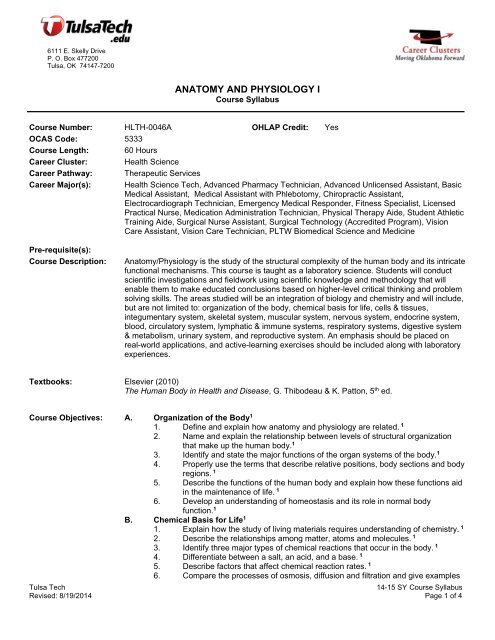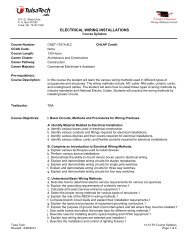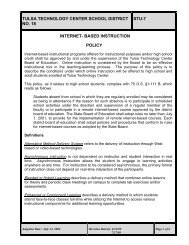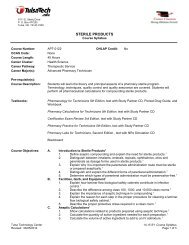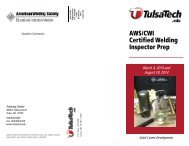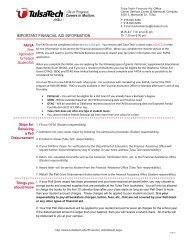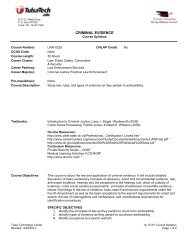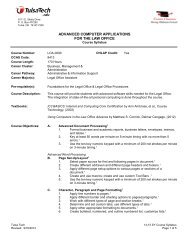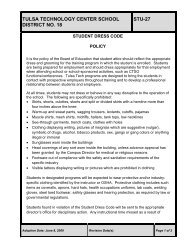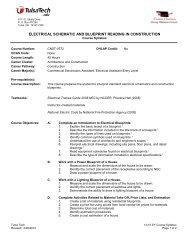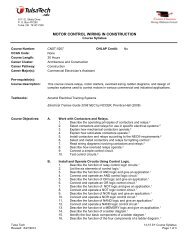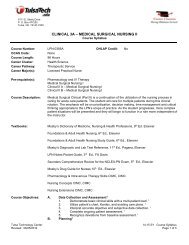Anatomy & Physiology I - Tulsa Technology Center
Anatomy & Physiology I - Tulsa Technology Center
Anatomy & Physiology I - Tulsa Technology Center
You also want an ePaper? Increase the reach of your titles
YUMPU automatically turns print PDFs into web optimized ePapers that Google loves.
6111 E. Skelly Drive<br />
P. O. Box 477200<br />
<strong>Tulsa</strong>, OK 74147-7200<br />
ANATOMY AND PHYSIOLOGY I<br />
Course Syllabus<br />
Course Number: HLTH-0046A OHLAP Credit: Yes<br />
OCAS Code: 5333<br />
Course Length: 60 Hours<br />
Career Cluster: Health Science<br />
Career Pathway: Therapeutic Services<br />
Career Major(s): Health Science Tech, Advanced Pharmacy Technician, Advanced Unlicensed Assistant, Basic<br />
Medical Assistant, Medical Assistant with Phlebotomy, Chiropractic Assistant,<br />
Electrocardiograph Technician, Emergency Medical Responder, Fitness Specialist, Licensed<br />
Practical Nurse, Medication Administration Technician, Physical Therapy Aide, Student Athletic<br />
Training Aide, Surgical Nurse Assistant, Surgical <strong>Technology</strong> (Accredited Program), Vision<br />
Care Assistant, Vision Care Technician, PLTW Biomedical Science and Medicine<br />
Pre-requisite(s):<br />
Course Description:<br />
<strong>Anatomy</strong>/<strong>Physiology</strong> is the study of the structural complexity of the human body and its intricate<br />
functional mechanisms. This course is taught as a laboratory science. Students will conduct<br />
scientific investigations and fieldwork using scientific knowledge and methodology that will<br />
enable them to make educated conclusions based on higher-level critical thinking and problem<br />
solving skills. The areas studied will be an integration of biology and chemistry and will include,<br />
but are not limited to: organization of the body, chemical basis for life, cells & tissues,<br />
integumentary system, skeletal system, muscular system, nervous system, endocrine system,<br />
blood, circulatory system, lymphatic & immune systems, respiratory systems, digestive system<br />
& metabolism, urinary system, and reproductive system. An emphasis should be placed on<br />
real-world applications, and active-learning exercises should be included along with laboratory<br />
experiences.<br />
Textbooks: Elsevier (2010)<br />
The Human Body in Health and Disease, G. Thibodeau & K. Patton, 5 th ed.<br />
Course Objectives: A. Organization of the Body 1<br />
1. Define and explain how anatomy and physiology are related. 1<br />
2. Name and explain the relationship between levels of structural organization<br />
that make up the human body. 1<br />
3. Identify and state the major functions of the organ systems of the body. 1<br />
4. Properly use the terms that describe relative positions, body sections and body<br />
regions. 1<br />
5. Describe the functions of the human body and explain how these functions aid<br />
in the maintenance of life. 1<br />
6. Develop an understanding of homeostasis and its role in normal body<br />
function. 1<br />
B. Chemical Basis for Life 1<br />
1. Explain how the study of living materials requires understanding of chemistry. 1<br />
2. Describe the relationships among matter, atoms and molecules. 1<br />
3. Identify three major types of chemical reactions that occur in the body. 1<br />
4. Differentiate between a salt, an acid, and a base. 1<br />
5. Describe factors that affect chemical reaction rates. 1<br />
6. Compare the processes of osmosis, diffusion and filtration and give examples<br />
<strong>Tulsa</strong> Tech<br />
14-15 SY Course Syllabus<br />
Revised: 8/19/2014 Page 1 of 4
ANATOMY AND PHYSIOLOGY I<br />
of their uses in the body. 1<br />
7. Explain the importance of water and salts to body homeostasis. 1<br />
8. Distinguish between organic and inorganic compounds. 1<br />
9. Compare the structures and functions of carbohydrates, lipids, proteins and<br />
nucleic acids. 1<br />
10. Distinguish between different types of proteins. 1<br />
11. Describe how and where enzymes work in the body. 1<br />
12. Compare and contrast the structure and functions of DNA and RNA. 1<br />
13. Explain the role of ATP in cell metabolism. 1<br />
C. Cells and Tissues 1<br />
1. Identify on a cell model or diagram the cell organelles and be able to explain<br />
their functions. 1<br />
2. Describe the structure of the plasma membrane, and explain how the various.<br />
transport processes account for the directional movements of specific<br />
substances across the plasma membrane. 1<br />
3. Describe different cell types and explain the functionality of the differences. 1<br />
4. Describe the cell cycle, including the phases of mitosis, and explain how the<br />
timing of cell division is regulated. 1<br />
5. Have an understanding of stem cells and how they are used in modern<br />
medical procedures and research. 1<br />
6. Name the four primary classes of human tissues and explain how they differ<br />
structurally and functionally. 1<br />
7. Know the anatomical location of the different tissue types. 1<br />
8. Describe ways the body repairs damaged tissue. 1<br />
9. Identify the various forms of cancer and describe how it affects the body. 1<br />
D. Integumentary System 1<br />
1. Have an understanding of the functions of the skin and be able to relate them<br />
to its structure. 1<br />
2. Recognize and identify the major skin structures when provided a diagram or<br />
model. 1<br />
3. Identify and know the purpose of the accessory structures of the skin. 1<br />
4. Describe the normal and pathological colors that the skin can have and explain<br />
their causes. 1<br />
5. Identify and differentiate between the three types of skin cancer. 1<br />
6. Describe the three classes of burns and the priorities in burn treatment. 1<br />
7. Understand the role of the integumentary system in maintaining homeostasis. 1<br />
E. Skeletal System 1<br />
1. Identify the subdivisions of the skeleton as axial or appendicular. 1<br />
2. State several functions of the skeletal system. 1<br />
3. Demonstrate knowledge, with the use of models or pictures, the major bones,<br />
their surface features, and basic functions. 1<br />
4. Describe the developmental aspects of the skeleton from formation in the fetus<br />
throughout the lifetime of the bones. 1<br />
5. Distinguish between and give the function of the four major classes of joints. 1<br />
6. Be able to identify and understand the function of tendons and ligaments. 1<br />
7. Understand the causes and current medical treatments of skeletal disorders<br />
and abnormalities. 1<br />
F. Muscular System 1<br />
1. Distinguish between the three types of muscles, and tell where they are<br />
located in the body. 1<br />
2. Describe the structure of a skeletal muscle with respect to location and names<br />
of its connective tissue coverings and attachments. 1<br />
3. Describe the microscopic structure and functional role of the skeletal muscle<br />
fiber. 1<br />
<strong>Tulsa</strong> Tech<br />
14-15 SY Course Syllabus<br />
Revised: 8/19/2014 Page 2 of 4
ANATOMY AND PHYSIOLOGY I<br />
4. Explain how muscle fibers are stimulated to contract and what occurs during a<br />
muscle twitch with regard to each component’s function. 1<br />
5. Explain how skeletal muscle fibers are innervated and how they contract. 1<br />
6. Explain how skeletal muscle meets its energy demands during rest and<br />
exercise. 1<br />
7. Explain oxygen debt and muscle fatigue and discuss situations that would<br />
cause them. 1<br />
8. Describe the effects of aerobic and resistance exercise on skeletal muscles<br />
and other body organs. 1<br />
9. List and define the criteria used in naming muscles and be able to provide an<br />
example to illustrate the use of each criterion. 1<br />
10. Name and identify, on a diagram or model, each of the muscles. State the<br />
origin and insertion for each, and describe the action of each. 1<br />
G. Nervous System 1<br />
1. List the general functions of the nervous system. 1<br />
2. Explain the structural and functional divisions of the nervous system. 1<br />
3. List the types of supporting cells and cite their functions. 1<br />
4. Describe the important anatomical regions of a neuron and relate each to a<br />
physiological role. 1<br />
5. Classify sensory receptors according to body location, structure, and stimulus<br />
detected. 1<br />
6. Describe the events that lead up to, happen during, and result after a nerve<br />
impulse and its conduction from one neuron to another. 1<br />
7. Identify and indicate the functions of the major regions of the cerebral<br />
hemispheres, diencephalons, brain stem, and cerebellum on a human brain<br />
model or diagram. 1<br />
8. Identify the three meningeal layers, and state their functions. 1<br />
9. Understand the formation and function of cerebrospinal fluid and the bloodbrain<br />
barrier. 1<br />
10. Describe spinal cord structure and list its functions. 1<br />
11. List the components of the peripheral nervous system. 1<br />
12. Distinguish between sensory, motor, and mixed nerves. 1<br />
13. Name the 12 pairs of cranial nerves and describe the body region and<br />
structures innervated by each. 1<br />
14. Name the four major nerve plexuses, give the major nerves of each, and<br />
describe their distribution. 1<br />
15. Distinguish between autonomic and somatic reflexes. 1<br />
16. Compare and contrast the general functions of the parasympathetic and<br />
sympathetic divisions. 1<br />
17. Understand from an anatomical and physiological perspective, the functions of<br />
sight, hearing & balance, taste, and smell. 1<br />
18. Describe the developmental aspects of the nervous system, from embryo to<br />
old age. 1<br />
1<br />
ODCTE Objective<br />
All unmarked objectives are TTC instructor developed.<br />
Teaching Methods:<br />
The class will primarily be taught by the lecture and demonstration method and supported by<br />
various media materials to address various learning styles. There will be question and answer<br />
sessions over material covered in lecture and media presentations. Supervised lab time is<br />
provided for students to complete required projects.<br />
<strong>Tulsa</strong> Tech<br />
14-15 SY Course Syllabus<br />
Revised: 8/19/2014 Page 3 of 4
ANATOMY AND PHYSIOLOGY I<br />
Grading Procedures:<br />
1. Students are graded on theory and lab practice and performance.<br />
2. Each course must be passed with seventy (70%) percent or better. Licensed Practical<br />
Nurse (LPN) require eighty (80%) percent or better due to accreditation or certification<br />
requirements<br />
3. Grading scale: A=90-100%, B=80-89%, C=70-79%, D=60-69%, F=50-59%.<br />
4. Students wanting to take advantage of college credit/alliance agreements must maintain an<br />
80% in their coursework.<br />
5. Career Major grades established during coursework are a major criteria in successfully<br />
obtaining certification.<br />
Description of<br />
Classroom,<br />
Laboratories, and<br />
Equipment:<br />
<strong>Tulsa</strong> <strong>Technology</strong> <strong>Center</strong> campuses are owned and operated by <strong>Tulsa</strong> <strong>Technology</strong> <strong>Center</strong><br />
School District No. 18. All programs provide students the opportunity to work with<br />
professionally certified instructors in modern, well-equipped facilities.<br />
Available<br />
Certifications/<br />
College Credit<br />
The student may be eligible to take state, national or industry exam after completion of the<br />
program. College credit may be issued from Oklahoma State University-Okmulgee or <strong>Tulsa</strong><br />
Community College. See program counselor for additional information.<br />
College Credit<br />
Eligibility:<br />
The student must maintain a grade point average of 2.0 or better. The following career major(s)<br />
may require a 3.0 GPA or better due to the Articulation Agreements and/or<br />
accreditation/certification requirements: Certified Dental Assistant, Emergency Medical<br />
Technician (EMT), Licensed Practical Nurse (LPN), Surgical First Assistant (SFA), Surgical<br />
Technologist, Surgical Nurse Assistant, Central Sterile Processing Technician.<br />
<strong>Tulsa</strong> Tech<br />
14-15 SY Course Syllabus<br />
Revised: 8/19/2014 Page 4 of 4


